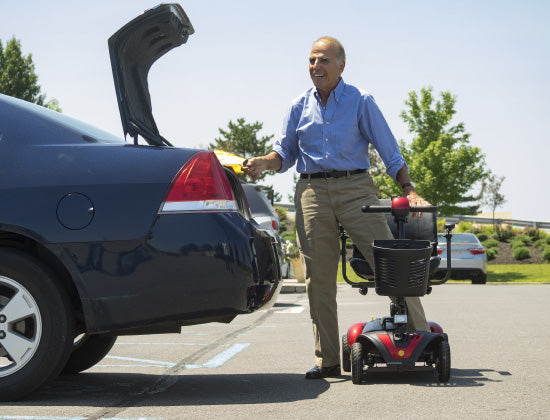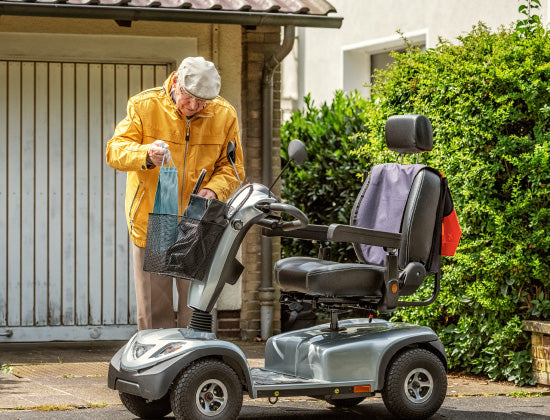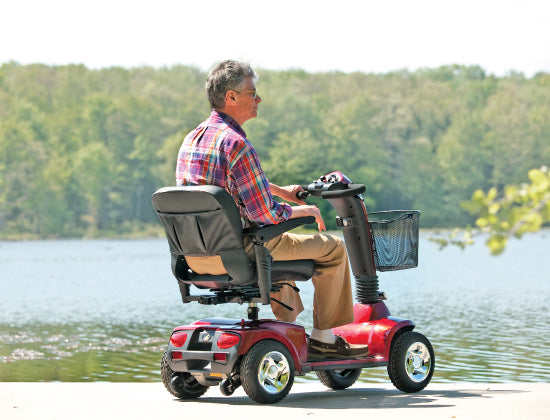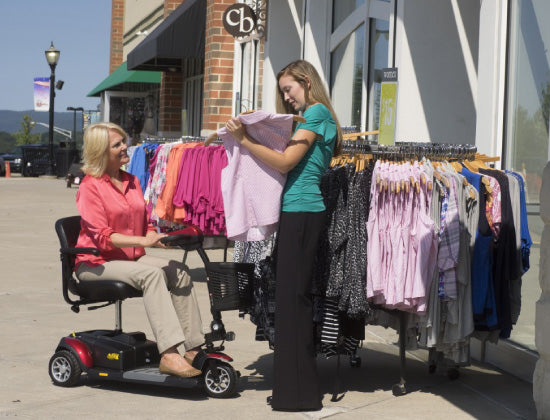
Mobility Scooter Comparison
Everything You Need to Know About Mobility Scooters! A scooter can be a lifesaver for individuals with significant mobility issues. These heavy-duty machines are capable of providing the safe, reliable mobility for indoor and outdoor use, and they come in a variety of designs meant to accommodate the lifestyle and needs of their users. We have made this guide to help you find out more about the different types of scooters, their uses, and information about their features.
Contact us for a FREE online evaluation
Types of Mobility Scooters and when to use them
There are a number of distinct types of mobility scooters, so most people can find one to accommodate their need. Being aware of the different types of mobility scooters, their unique advantages and disadvantages can make it easier to determine which one will be right for you or your loved one. When someone is opting for a scooter over a power chair that means they have good seated balance and can use both hands to drive the scooter. Scooters take more physical ability to drive than a scooter and they also do not have the ability to offer postural seating supports like side-laterals or after market cushions.

Travel or Portable Scooter
For anyone who wants to take their scooter on the go, but does not want to install a lift on the back of their car or rely solely on the bus would need to get a portable scooter. These scooters disassemble or fold to make them easier to lift in the trunk or stowed on a plane. They have airline safe, non-spillable batteries and despite being in the smaller family of scooters, they can accommodate someone up to 330 lbs. with the Buzzaround XL HD model. With the scooters that disassemble, generally no piece is over 35 lbs., then with the folding single piece scooters you have to be able to lift 50 lbs and up. You can read more on Transporting Mobility Scooters
Shop Travel Scooters
Full Size Scooter
These are best for people who mostly use their scooter outdoors. Full size scooter can accommodate bigger people and has bigger seat options with taller backs. The portable scooters generally have no seat options (except the Buzzaround HD offers a tall back now). The full size scooters have bigger batteries and can go longer distances. They do not make good indoor scooters though, they are just too big to turn around.

4-Wheeled Scooter
The 4-wheel scooter has a larger turn radius, but the added wheel gives more security when traveling over uneven terrain or inclines. They are ideal for outdoor strolls on mostly even ground. They can handle grass and gravel usually, but so can their 3-wheel counterparts. The main difference maker here is that they are more stable with a wider turning radius. There is one 4-wheel model, the Go-Go Zero Turn 4-wheel scooter, that has the stability of having 4 wheels, but turns like a 3 wheel.

3-Wheel Scooter
The 3-wheel scooter is a great option for the primarily indoor user because it has a tighter turn radius making it easier to avoid obstacles and move through doorways and around corners. The difference in stability from a 4 wheel is slight, although if someone is predominantly using scooter outside 4-wheel is better, but for the indoor user the trade-off in improved maneuverability is worth it.
Main Features of a Mobility Scooter
It is good to familiarize yourself with the main features of a mobility scooter before making a purchase to fully understand which ones you require so that you can ensure they are included in the model you are buying.
-
Battery
Batteries can always be replaced or upgraded though it is important to note that the higher the power, the more weight will be added onto the scooter. The most common battery for mobility scooters is a 12V, which can be recharged from a wall outlet. How often you use your scooter and what kind of terrain it is used over will determine how long the individual charges last and the battery's lifespan. They typically last around 18 months before needing a replacement but can last several years if maintained and only used twice a day or less.
-
Chassis
Your scooter's base frame is going to be attached to each wheel, the seat post, steering column, motor, and battery. Most chassis are made of either metal or fiberglass, and depending on the model you buy, some sections may be removable
-
Tiller
The steering column, or tiller, is sometimes adjustable. It is a vertical column that houses the control box and is responsible for steering.
-
Handlebars
The handlebars are located at the top of the steering column and allow you to control the direction. They can come in several designs. Standard handlebars are straight bars. For these, the controls are located on the tiller and commanded using the user's thumbs. Delta tiller handles have a wrap-around style, which is more comfortable because the wrist can rest on the handlebars, reducing fatigue.
-
Seat and armrest
There is a lot of versatility surrounding the seat and armrest, depending on what model you end up choosing to purchase. Some have armrests that can be moved to accommodate getting in and out of the chair, while others are locked into place. You will need to check the model's specifications to determine what kind of movement and control will be provided. Some have pieces that can be detached for easier transportation.
-
Tires
More lightweight, compact mobility scooters will usually have puncture-proof tires that are not filled with air and provide less comfort when moving over bumps and terrain changes. Heavier duty scooters tend to have the more comfortable air-filled pneumatic tires. Air-filled tires should be checked before every use to ensure they are not inflating or potentially leaking.
-
Battery indicator
Although the battery indicator is meant to show you the life of your current battery charge, it can be unreliable in some models. Before purchasing a mobility scooter for travel or outdoor use, make sure that it is one with an accurate battery indicator; otherwise, you run the risk of being stuck away from a charging location if it dies. These gauges are usually located between the handlebars on the top of the tiller
-
Brakes
Pressing certain buttons (wig-wag, etc.) or driving the scooter is generally what releases the braking mechanism that is otherwise permanently engaged for safety reasons. For some mobility scooters, the moment you release the wig-wag, the device automatically engages the brakes, while other models require you to turn on the brakes manually.
-
Control panel
The main control panel on most models is located on top of the tiller, between the handlebars. They can include odometers, digital readouts, color coding indicators, and other visual representations of the controls and gauges to monitor speed, battery charge, and other things
-
Ignition
Some models require a key to operate, while others have a simple on-off switch. For anyone who intends to leave their scooter in a public space, it is best to have one with a key, or else the scooter will be incredibly easy to steal
-
Speed settings
There will be a speed indicator that shows you how fast you are going. It is located on the control panel and can come in various forms. A few have visual representations of speed, and others have more traditional gauges. You can have a pre-set for some mobility scooters, while others require you to control the speed manually.
-
Forward and reverse bar "Wig-Wag"
A wig-wag is a button that you press which can control forward or backward movement on your scooter. Some versions can also control speed based on the pressure used against the button (lighter pressure is slower, harder pressure is faster). These are located on the top of the tiller between the handlebars and controlled by the user's thumb.
-
Freewheel mode
This is like neutral for a car. It disengages the drive mechanism and allows you to maneuver it freely. This is most useful for storage. Drive mode must be re-engaged before it can be used.
-
Horn
Before going outdoors, you will want to check that your horn is in working order. It is often designed to automatically turn on when a backward motion is engaged. This is one of the most crucial safety features and is designed to give a warning.
-
Lights and Mirrors
Some mobility scooters have lights and mirrors because they are capable of being ridden on a motorway and must be able to signal intent. These are essential if you will be driving around motorways where fast-moving vehicles are present.
Choosing the Correct Mobility Scooter
There factors to look at when shopping for your prospective mobility scooter. These include such things as your lifestyle (are you active, regularly use public transportation, need to fit your scooter in your car, etc.) and your mobility issues. Some people need to have various features to make it easier to get in and off the scooter, while others do not. If someone cannot use both hands to drive a scooter will not be suitable, a power chair would be a better option. For someone who has poor seated balance and needs seating and positioning aides then again a power chair would be the best option.
If you require a machine that will be able to transport you up hills or over uneven terrains, then a heavy-duty or 4-wheel scooter would be right for you. Anyone who enjoys the outdoors will find these both are easier to move around and more comfortable over bumps and turns. More lightweight models may still be capable of traversing the terrain but will get worn out faster if used in this way often.
For anyone who regularly uses their own transportation, airplanes, or cruise ships then a travel scooter is best because it is lighter, possibly foldable, and easier to handle into and out of tight spaces such as a car trunk.

Mobility Scooters FAQs
-
Can mobility scooters use cycle lanes?
Mobility scooters are purposefully designed not to go fast enough for cycle lanes. Not even class-3 models can be ridden in the cycle lane except in very limited circumstances (the sidewalk is obstructed, etc.). Most local areas have regulations regarding what is and is not permitted in cycle lanes. You can look at your city's website for local traffic laws or reach out to the office of transportation in your area.
Bike lanes in park areas should also be avoided by mobility scooters as they can impede traffic. There are select circumstances, and you will want to check park guidelines before entering as there are often stipulations for using a mobility scooter within private or public parks. -
Can I upgrade to a bigger battery on my mobility scooter?
Whether you can replace your battery with an upgrade will depend on the model. Some are built to allow bigger batteries, while others are not. The benefits of adding a bigger battery include increased life per charge and a larger radius of travel.
If you have never operated a mobility scooter, it might be better to wait until your newly acquired scooter needs a battery replacement before upgrading to a bigger one. You may find that you either do not need or do not want more power or speed than what comes standard. -
How do you increase the speed of a mobility scooter?
Changing the battery to a bigger one will also affect your mobility scooter's capability to go faster. Some of the models come with a built-in speed limiter, and removing it can increase your speed.
-
Which is the lightest mobility scooter?
Travel mobility scooters are the lightest option. You can find some whose heaviest piece is as light as 34 pounds. For anyone who is frequently traveling across the country or internationally, having a lightweight scooter can be invaluable.
-
Can a mobility scooter fit in a car?
Compact models can fit in your vehicle. While travel scooters are specifically designed for this and are better at fitting into small spaces like a car trunk, other types of mobility scooters may also come with folding features that will allow them to fit into a car.
-
Do I need a number plate on my mobility scooter?
Mobility scooters do not require a number plate to be operated. If you intend to use your scooter on or near a motorway, then you will want to check local regulations regarding their use and any necessary registrations that might be required.

